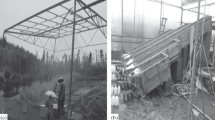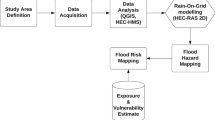Abstract
A comprehensive process-based rainfall-runoff model for simulating overland flow generated in rills and on interrill areas of a hillslope is evaluated using a laboratory experimental data set. For laboratory experiments, a rainfall simulator has been constructed together with a 6.50 m × 1.36 m erosion flume that can be given adjustable slopes changing between 5 % and 20 % in both longitudinal and lateral directions. The model is calibrated and validated using experimental data of simulated rainfall intensities between 45 and 105 mm/h. Results show that the model is capable of simulating the flow coming from the rill and interrill areas. It is found that most of the flow occurs in the form of rill flow. The hillslope-scale model can be used for better prediction of overland flow at the watershed-scale; it can also be used as a building block for an associated erosion and sediment transport model.








Similar content being viewed by others
References
Aksoy H, Kavvas ML (2005) A review of hillslope and watershed scale erosion and sediment transport models. Catena 65:247–271
Aksoy H, Unal NE, Cokgor S, Gedikli A, Yoon J, Koca K, Inci SB, Eris E (2012) A rainfall simulator for laboratory-scale assessment of rainfall-runoff-sediment transport processes over a two-dimensional flume. Catena 98:63–72
Aksoy H, Unal NE, Cokgor S, Gedikli A, Yoon J, Koca K, Inci SB, Eris E, Pak G (2013) Laboratory experiments of sediment transport from a bare soil with rill. Hydrolog Sci J 58(7):1505–1518
Arguelles ACC, Jung M, Pak G, Aksoy H, Kavvas ML, Yoon J (2013) ) Evaluation of overland flow model for a hillslope using laboratory flume data. Water Sci Technol 68(5):1188–1194
Arguelles ACC, Jung M, Mallari KJB, Pak G, Aksoy H, Kavvas LM, Eris E, Yoon J, Lee Y, Hong S (2014) Evaluation of an erosion-sediment transport model for a hillslope using laboratory flume data. J Arid Land 6(6):647–655
Bergström S (1995) The HBV model. In: Singh VP (ed) Computer Models of Watershed Hydrology, Chapter 13, Water Resources Publications, pp 443–476
Beven KJ, Kirkby MJ (1979) A physically based, variable contributing area model of basin hydrology. Hydrolog Sci Bull 24(1):43–69
Burnash, RJC (1995) The NWS River Forecast System – Catchment Model. In: Singh VP (ed) Computer Models of Watershed Hydrology, Chapter 10, Water Resources Publications, pp 311–366
Giakoumakis S, Tsakiris G (2001) Experimental validation of a linearized kinematic wave equation for micro-catchment water harvesting design. Water Resour Manag 15(4): 235–246.
Goldberg DE (1989) Genetic algorithms for search, Optimization, and machine learning. Addison-Wesley, USA.
Govindaraju RS, Kavvas ML, Tayfur G (1992) A simplified model for two-dimensional overland flows. Adv Water Resour 15(2):133–141
Horton RE (1933) The role of infiltration in the hydrological cycle. EOS T Am Geophys Un 14:446–460
Hundecha Y, Bardossy A, Werner HW (2001) Development of a fuzzy logic-based rainfall-runoff model. Hydrolog Sci J 46(3):363–376
Kavvas M, Chen Z, Dogrul C, Yoon J, Ohara N, Liang L, Aksoy H, Anderson M, Yoshitani J, Fukami K, Matsuura T (2004) Watershed Environmental Hydrology (WEHY) model based on upscaled conservation equations: hydrologic module. J Hydrol Eng 9(6):450–464
Kavvas M, Yoon J, Chen Z, Liang L, Dogrul E, Ohara N, Aksoy H, Anderson M, Reuter J, Hackley S (2006) Watershed environmental hydrology model: environmental module and its application to a california watershed. J Hydrol Eng 11(3):261–272
Lin GF, Chen LH (2004) A non-linear rainfall-runoff model using radial basis function network. J Hydrol 289(1):1–8
Madsen H (2000) Automatic calibration of a conceptual rainfall–runoff model using multiple objectives. J Hydrol 235(3):276–288
Mallari KJB, Arguelles ACC, Kim H, Aksoy H, Kavvas ML, Yoon J (2015a) Comparative analysis of two infiltration models for application in a physically based overland flow model. Environ Earth Sci 74(2):1579–1587
Mallari KJB, Kim H, Aksoy H, Yoon J (2015b) A comparison of two infiltration models applied to simulation of overland flow over a two-dimensional flume. Water Sci Technol 71(9):1325–1332
Minns AW, Hall MJ (1996) Artificial neural networks as rainfall-runoff models. Hydrolog Sci J 41(3):399–417
Post DA, Jakeman AJ (1999) Predicting the daily streamflow of ungauged catchments in SE Australia by regionalising the parameters of a lumped conceptual rainfall-runoff model. Ecol Model 123(2):91–104
Seibert J (1999) Regionalisation of parameters for a conceptual rainfall-runoff model. Agric For Meteorol 98:279–293
Singh VP, Woolhiser DA (2002) Mathematical modeling of watershed hydrology. J Hydrol Eng 7(4):270–292
Sugawara M (1995) Tank model. In: Singh VP (ed), Computer models of watershed hydrology, Chapter 7, Water Resources Publications, 165–214
Tayfur G (2001) Modeling two-dimensional erosion process over infiltrating surfaces. J Hydrol Eng 6(3):259–262
Tayfur G (2007) Modelling sediment transport from bare rilled hillslopes by areally averaged transport equations. Catena 70(1):25–38
Tayfur G (2012) Soft computing in water resources engineering. WIT Press, Southampton, United Kingdom
Tayfur G, Kavvas ML (1998) Areally-averaged overland flow equations at hillslope scale. Hydrolog Sci J 43(3):361–378
Yoon J, Aksoy H, Kavvas ML, Arguelles ACC, Mallari KJB (2014) A field application of physically-based erosion and sediment transport model for hillslope response. La Houille Blanche 2:81–87
Zollweg JA, Gburek WJ, Steenhuis TS (1996) SMoRMod-a GIS-integrated rainfall-runoff model. Trans ASAE 39(4):1299–1307
Acknowledgments
This study is based on the international project ‘Development of a hillslope-scale sediment transport model’ bilaterally supported by TUBITAK (Scientific and Technical Research Council of Turkey, project no. 108Y250) and KRF (Korea Research Foundation). Comments by the reviewers are greatly appreciated.
Author information
Authors and Affiliations
Corresponding author
Rights and permissions
About this article
Cite this article
Aksoy, H., Gedikli, A., Unal, N.E. et al. Rainfall-Runoff Model Considering Microtopography Simulated in a Laboratory Erosion Flume. Water Resour Manage 30, 5609–5624 (2016). https://doi.org/10.1007/s11269-016-1439-y
Received:
Accepted:
Published:
Issue Date:
DOI: https://doi.org/10.1007/s11269-016-1439-y




